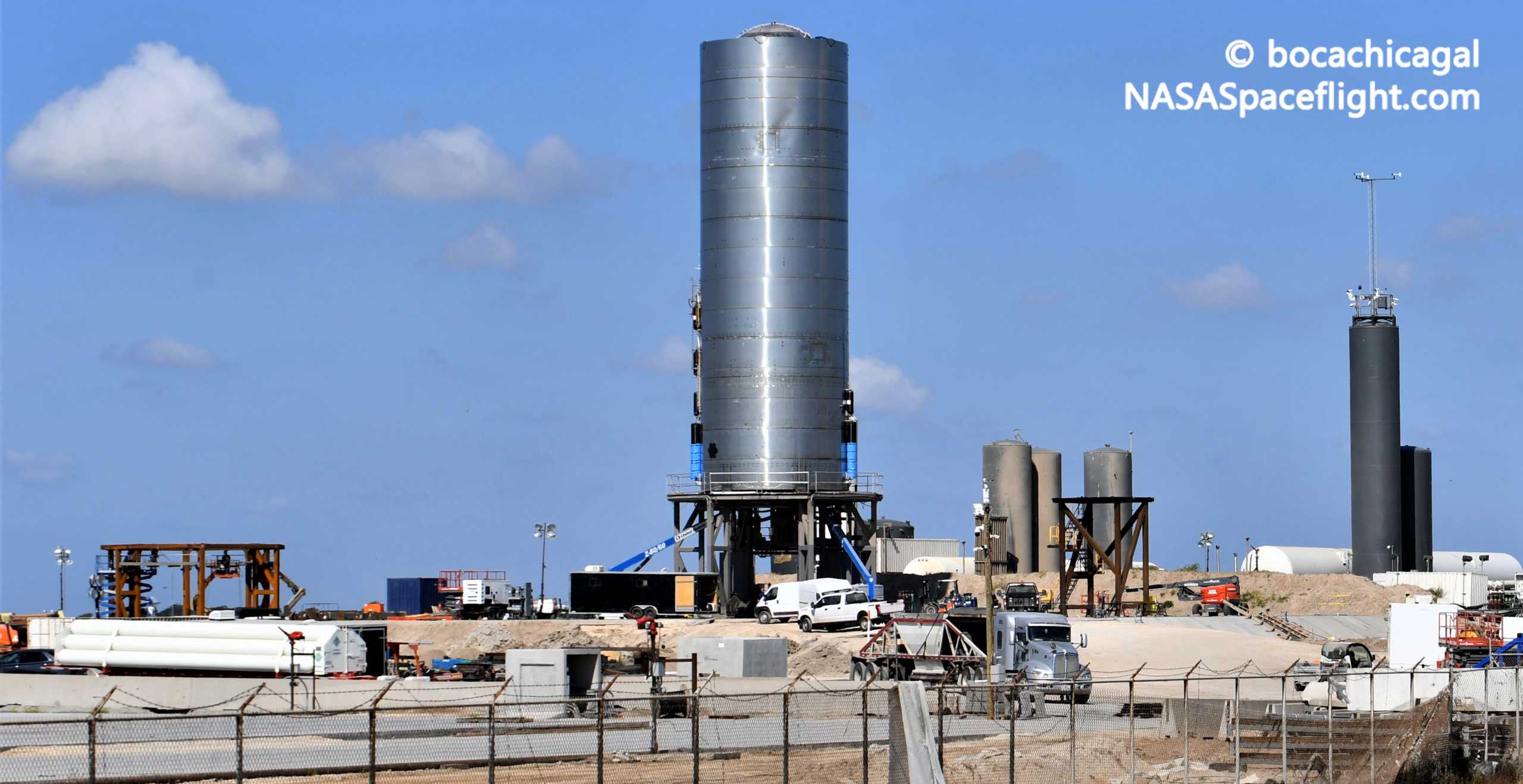
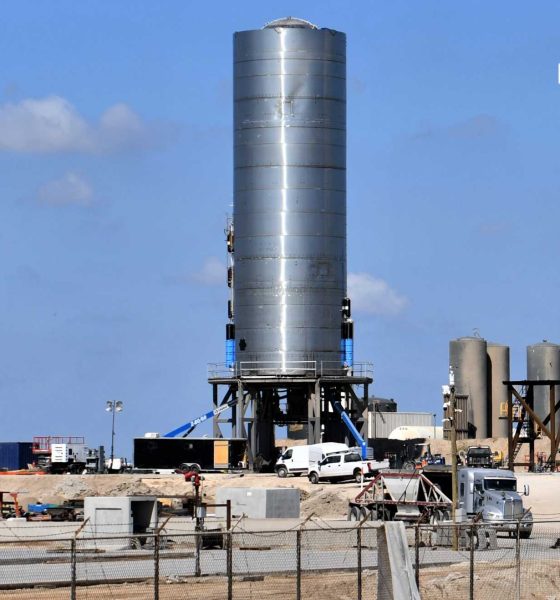
News
SpaceX installs Starship Raptor engine, moves next test forward as storms near
SpaceX has installed a Raptor engine on its sixth Starship prototype in preparation for a static fire test that is now scheduled later this week.
Originally planned no earlier than (NET) Monday, August 24th, SpaceX recently moved the Starship test window forward 24 hours to Sunday, August 23rd. Why is a mystery but the company may be attempting to squeeze in the test before a tropical storm is expected to make landfall in South Texas.
Per NOAA, the impact of that storm will begin to be felt at SpaceX’s Boca Chica factory as early as Sunday, bringing with it a ~20-40% chance of rain showers and thunderstorms from Sunday to Thursday, at minimum. SpaceX weathered a glancing blow from Hurricane Hanna just a few weeks ago and it’s looking like the week of August 23rd will have fairly similar – if not milder – conditions.
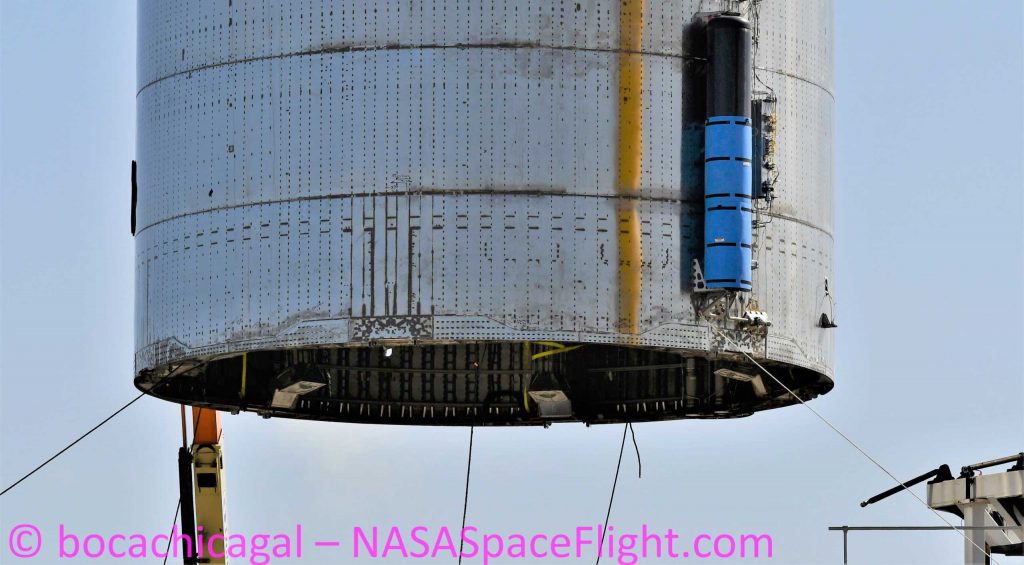
The forecast for Sunday shows a 20% chance of rain storms and thunderstorms, meaning that there’s at least an 80% chance that SpaceX – barring technical delays – will be able to attempt Starship SN6’s first static fire test sometime between 8am and 8pm local (UTC-5). Like all previous SNx Starship prototypes, that test will begin with a wet dress rehearsal – pressurizing and loading the rocket with liquid methane and oxygen – and proceed into what is known as a Raptor spin prime.
If the engine spins up its turbopumps with pressurized helium (spin prime) without issue, SpaceX will recycle the flow and follow with a preburner tests, ensuring that the hardware that turns Raptor’s propellant into combustible gas is working as expected. Finally, if both of those tests are completed, SpaceX will recycle the flow once again (essentially moving the countdown clock back) and attempt a Raptor ignition and static fire.
Given enough confidence in the engine and Starship prototype, SpaceX could technically move directly from a WDR into a static fire attempt with no delay in between, as a static fire technically begins with a sort of (incredibly brief) spin prime and preburner test. It’s more likely that SpaceX will choose a more cautious multi-step test for the first major Raptor operations with a new Starship prototype.
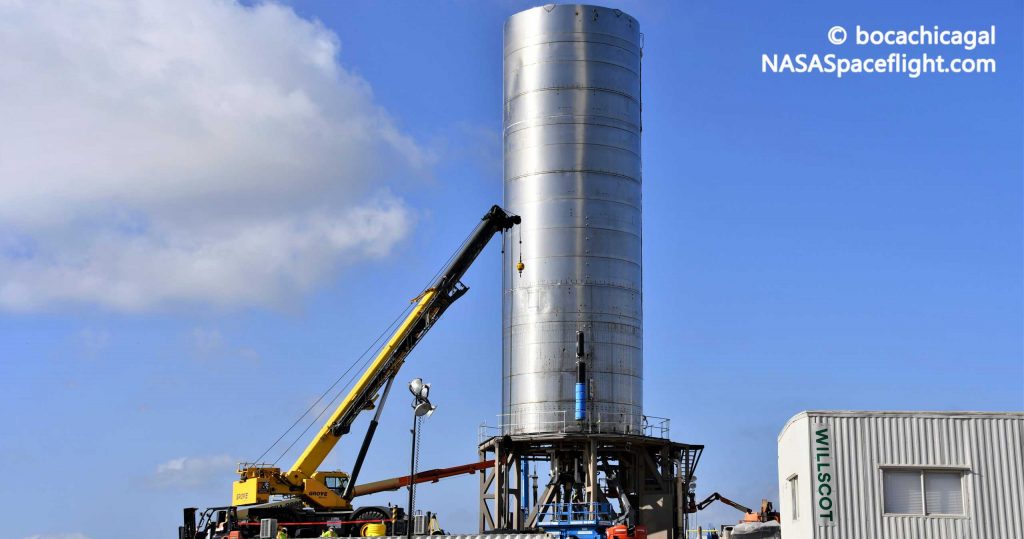
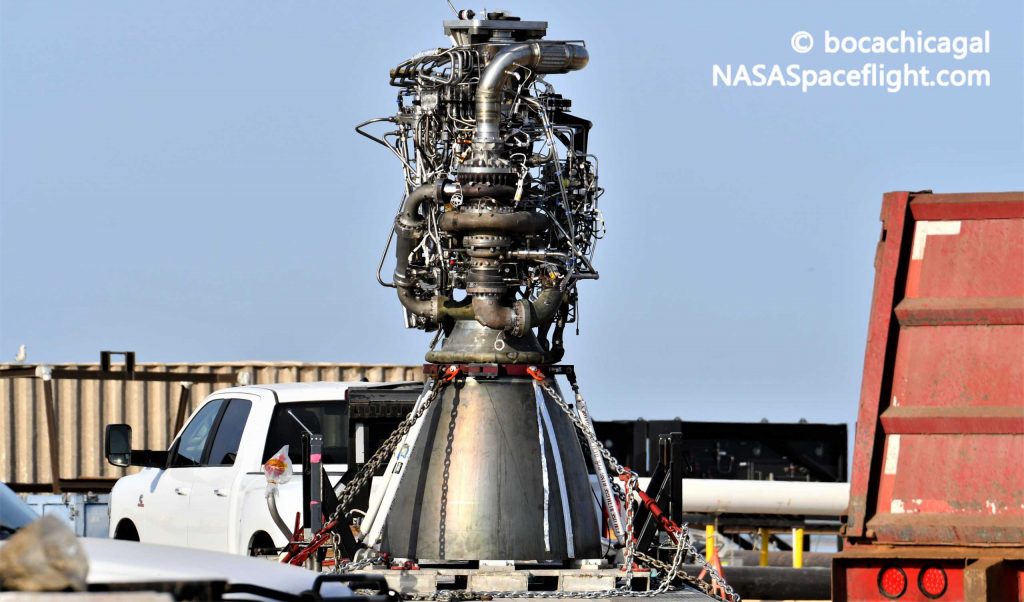
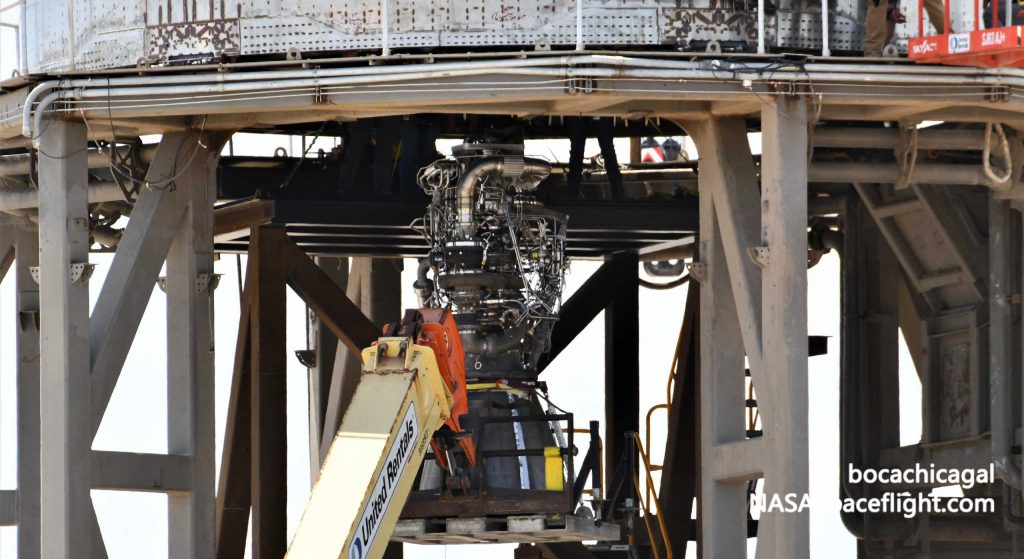
Based on Starship SN5’s successful static fire and hop test debut just three weeks ago, Starship SN6 could be ready for its own hop debut as early as Friday, August 28th, assuming a successful static fire on the first attempt and a few aborted hop attempts after that. If SpaceX avoids all delays, SN6 could technically hop as early as Thursday. According to CEO Elon Musk, the reason SpaceX is attempting another short Starship hop in the first place is to “smooth out [the] launch process” and “make flights simple & easy — many per day.”
As such, it’s actually reasonable to assume that SpaceX will try to test and hop Starship SN6 more quickly than SN5. Whether the company can manage that challenging feat with early Starship prototypes remains to be seen, of course, but if the coming storm doesn’t pose too much of a threat, we’ll find out soon enough.
Check out Teslarati’s Marketplace! We offer Tesla accessories, including for the Tesla Cybertruck and Tesla Model 3.

News
Tesla FSD fleet is nearing 7 billion total miles, including 2.5 billion city miles
As can be seen on Tesla’s official FSD webpage, vehicles equipped with the system have now navigated over 6.99 billion miles.

Tesla’s Full Self-Driving (Supervised) fleet is closing in on almost 7 billion total miles driven, as per data posted by the company on its official FSD webpage.
These figures hint at the massive scale of data fueling Tesla’s rapid FSD improvements, which have been quite notable as of late.
FSD mileage milestones
As can be seen on Tesla’s official FSD webpage, vehicles equipped with the system have now navigated over 6.99 billion miles. Tesla owner and avid FSD tester Whole Mars Catalog also shared a screenshot indicating that from the nearly 7 billion miles traveled by the FSD fleet, more than 2.5 billion miles were driven inside cities.
City miles are particularly valuable for complex urban scenarios like unprotected turns, pedestrian interactions, and traffic lights. This is also the difference-maker for FSD, as only complex solutions, such as Waymo’s self-driving taxis, operate similarly on inner-city streets. And even then, incidents such as the San Francisco blackouts have proven challenging for sensor-rich vehicles like Waymos.
Tesla’s data edge
Tesla has a number of advantages in the autonomous vehicle sector, one of which is the size of its fleet and the number of vehicles training FSD on real-world roads. Tesla’s nearly 7 billion FSD miles then allow the company to roll out updates that make its vehicles behave like they are being driven by experienced drivers, even if they are operating on their own.
So notable are Tesla’s improvements to FSD that NVIDIA Director of Robotics Jim Fan, after experiencing FSD v14, noted that the system is the first AI that passes what he described as a “Physical Turing Test.”
“Despite knowing exactly how robot learning works, I still find it magical watching the steering wheel turn by itself. First it feels surreal, next it becomes routine. Then, like the smartphone, taking it away actively hurts. This is how humanity gets rewired and glued to god-like technologies,” Fan wrote in a post on X.
News
Tesla starts showing how FSD will change lives in Europe
Local officials tested the system on narrow country roads and were impressed by FSD’s smooth, human-like driving, with some calling the service a game-changer for everyday life in areas that are far from urban centers.

Tesla has launched Europe’s first public shuttle service using Full Self-Driving (Supervised) in the rural Eifelkreis Bitburg-Prüm region of Germany, demonstrating how the technology can restore independence and mobility for people who struggle with limited transport options.
Local officials tested the system on narrow country roads and were impressed by FSD’s smooth, human-like driving, with some calling the service a game-changer for everyday life in areas that are far from urban centers.
Officials see real impact on rural residents
Arzfeld Mayor Johannes Kuhl and District Administrator Andreas Kruppert personally tested the Tesla shuttle service. This allowed them to see just how well FSD navigated winding lanes and rural roads confidently. Kruppert said, “Autonomous driving sounds like science fiction to many, but we simply see here that it works totally well in rural regions too.” Kuhl, for his part, also noted that FSD “feels like a very experienced driver.”
The pilot complements the area’s “Citizen Bus” program, which provides on-demand rides for elderly residents who can no longer drive themselves. Tesla Europe shared a video of a demonstration of the service, highlighting how FSD gives people their freedom back, even in places where public transport is not as prevalent.
What the Ministry for Economic Affairs and Transport says
Rhineland-Palatinate’s Minister Daniela Schmitt supported the project, praising the collaboration that made this “first of its kind in Europe” possible. As per the ministry, the rural rollout for the service shows FSD’s potential beyond major cities, and it delivers tangible benefits like grocery runs, doctor visits, and social connections for isolated residents.
“Reliable and flexible mobility is especially vital in rural areas. With the launch of a shuttle service using self-driving vehicles (FSD supervised) by Tesla in the Eifelkreis Bitburg-Prüm, an innovative pilot project is now getting underway that complements local community bus services. It is the first project of its kind in Europe.
“The result is a real gain for rural mobility: greater accessibility, more flexibility and tangible benefits for everyday life. A strong signal for innovation, cooperation and future-oriented mobility beyond urban centers,” the ministry wrote in a LinkedIn post.
News
Tesla China quietly posts Robotaxi-related job listing
Tesla China is currently seeking a Low Voltage Electrical Engineer to work on circuit board design for the company’s autonomous vehicles.

Tesla has posted a new job listing in Shanghai explicitly tied to its Robotaxi program, fueling speculation that the company is preparing to launch its dedicated autonomous ride-hailing service in China.
As noted in the listing, Tesla China is currently seeking a Low Voltage Electrical Engineer to work on circuit board design for the company’s autonomous vehicles.
Robotaxi-specific role
The listing, which was shared on social media platform X by industry watcher @tslaming, suggested that Tesla China is looking to fill the role urgently. The job listing itself specifically mentions that the person hired for the role will be working on the Low Voltage Hardware team, which would design the circuit boards that would serve as the nervous system of the Robotaxi.
Key tasks for the role, as indicated in the job listing, include collaboration with PCB layout, firmware, mechanical, program management, and validation teams, among other responsibilities. The role is based in Shanghai.
China Robotaxi launch
China represents a massive potential market for robotaxis, with its dense urban centers and supportive policies in select cities. Tesla has limited permission to roll out FSD in the country, though despite this, its vehicles have been hailed as among the best in the market when it comes to autonomous features. So far, at least, it appears that China supports Tesla’s FSD and Robotaxi rollout.
This was hinted at in November, when Tesla brought the Cybercab to the 8th China International Import Expo (CIIE) in Shanghai, marking the first time that the autonomous two-seater was brought to the Asia-Pacific region. The vehicle, despite not having a release date in China, received a significant amount of interest among the event’s attendees.








